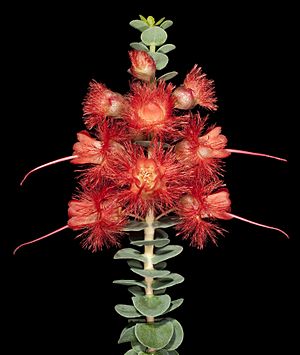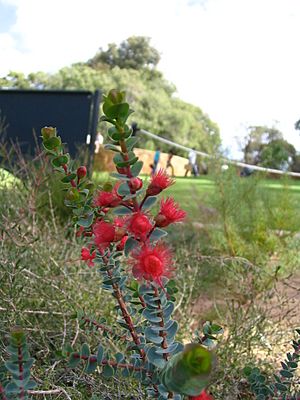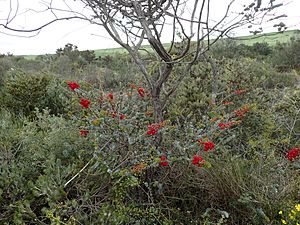Scarlet featherflower facts for kids
Quick facts for kids Scarlet featherflower |
|
|---|---|
 |
|
 |
|
| V. grandis in Kings Park | |
| Scientific classification | |
| Genus: |
Verticordia
|
| Species: |
grandis
|
Verticordia grandis is a big, woody shrub found in Southwest Australia. Its name, grandis, comes from Latin and means "large." This refers to its big flowers, leaves, and how tall it can grow. People love its large, bright flowers, which are often picked and grown. It's also known by the common name scarlet featherflower. This plant was the first in the Myrtaceae family to be changed using genetic engineering.
Contents
What is the Scarlet Featherflower?
Verticordia grandis is a type of Verticordia plant. These plants belong to the Myrtaceae family, which is famous for its beautiful flowers. Many people think Verticordia grandis is the most amazing and well-known species in its group.
Its large size and bright red flowers make it easy to tell apart from other similar plants. These shrubs grow upright and can reach heights of 0.7 to 4.0 meters. They usually have one or more main stems that spread out from 0.3 to 3.0 meters wide.
Some plants grow tall and straight. However, it's more common to see them as bushy regrowth coming from a special underground part called a lignotuber. This often happens after bushfires or other events. New stems that grow back are often reddish at first. As the plant gets older, its leaves turn a bluish or grey color.
Flowers and Leaves
The flowers of the scarlet featherflower grow in tight groups at the top of the branches. They start out white and then change to a deep red. Each flower can be up to 25 millimeters wide and doesn't have a scent. The central part of the flower, called the style, sticks out up to 25 millimeters and curves slightly at the end. The petals are joined together to form a tube, and the sepals (leaf-like parts under the petals) look feathery.
You can find these flowers blooming throughout the year. However, the main flowering time is from August to January. The flowers open one after another, not all at once.
The leaves are about 18 to 25 millimeters long and have a round shape. They are lighter around the edges and partly wrap around the stem. The leaves near the flowers look similar to those on the lower branches. If you crush the leaves, they smell nice, almost like a floral scent. They have small glands on their surface that contain oil. Sometimes, if the plant is stressed, its leaves might turn a shade of purple.

Plant Growth and Age
When these shrubs grow without being disturbed, especially the taller ones, they can look a bit straggly with fewer flowers. But if they grow back from a lignotuber, or if they are grown in gardens, they become more compact and produce many flowers. Whether they are left alone or exposed to things like bushfires, Verticordia grandis plants often live for about 100 years!
Where Does it Grow?
Verticordia grandis grows in yellow, grey, and white sandy soils. It's especially common in an area called the Geraldton Sandplains. You can find this plant in heathland and open scrub areas. It's also sometimes found near a type of soil called laterite.
The plant's main area is south of Geraldton and east towards Three Springs. Its range also stretches south between Geraldton and Perth to a place called Cataby. Most of these plants grow within 30 miles of the coast.
This species is not currently considered in danger of disappearing. Its strong root system helps it survive fires, disturbances, and physical damage. However, a lot of its natural habitat has been cleared for farming, which has likely affected how many plants there are and where they grow. There's one plant found far away in Dalwallinu that is protected on private land. Scientists think this might be a leftover from a time when the plant grew even further east.
How Does it Survive and Reproduce?
The strong root system of Verticordia grandis helps it live for up to 100 years, especially when it comes to surviving fires and soil changes. It has a lignotuber, which is a special woody swelling at or below ground level. This allows the plant to grow back new stems within a month after a bushfire. Not many plants in the Verticordia group have this ability.
Scientists don't fully understand how Verticordia plants are pollinated. However, we do know that V. grandis and other red-flowered species are pollinated naturally by birds like honeyeaters. When this plant is grown in gardens, birds like the singing, little brown, New Holland honeyeaters, and the western spinebill have been seen visiting its flowers.
How People Use Scarlet Featherflower
People have used Verticordia grandis as a source of cut flowers and as a plant for gardens. Because so many people wanted these flowers, and they were being picked too much, scientists started studying ways to grow them commercially. Researchers have successfully used a method called micropropagation, which involves changing the plant's genes, to grow them for the flower industry. This was the first time a plant from the Myrtaceae family was genetically engineered. Since the 1990s, more and more scientific papers have been published about this plant.
Flowers for Sale
The large, bright red flowers of Verticordia grandis have been admired and collected ever since they were first discovered by Europeans. James Drummond, who first described the plant, even noted that local people used the flowers as decorations. He called it "the most beautiful of Australian plants" in his first report.
However, cut Verticordia grandis flowers don't last very long in a vase, usually less than 10 days. This is shorter than other Verticordia flowers that are harvested. Also, treatments that usually make cut flowers last longer don't work well for this plant. To sell these flowers to other countries, a way to make them last longer is needed.
Dried flowers that were picked when freshly opened are less fragile and last longer in decorations. In the past, people sometimes picked these flowers carelessly without a license. Now, the flower industry gets its supply from professional pickers or growers. Scientists hope that the successful genetic changes made in 1993 will lead to more ways to grow this plant using micropropagation. This was done by using special cells found in the leaves.
Growing in Gardens
Verticordia grandis has been successfully grown as a decorative plant in suburban areas. Sometimes, it's grown from seeds in places with a mediterranean climate. Other times, people use cuttings from the plant and graft them onto stronger species. This has been tried with Darwinia citriodora and Chamelaucium uncinatum (Geraldton wax) plants, which provide the rootstock (the root system).
A botanical artist named Margaret Pieroni used a 10-year-old plant from her own garden to create a drawing for Curtis's Botanical Magazine. Plants grown in gardens usually don't get as tall as those in the wild, typically growing between 1 and 2 meters. They can also take a while to get established.
Gardeners often prune the plant to make it bushy, which looks neater and helps it produce more flowers. This pruning is done quite a lot when the plant is mature. It's important to keep pruning the plant to new wood to stop it from becoming straggly. Verticordia plants can be hard to grow in wetter places. However, people have had success growing V. grandis in Sydney by using soil that drains water very well and planting it in an open spot.
Images for kids
-
Dried specimen collected near Eneabba
-
V. grandis and other Verticordia species, painting by Ellis Rowan





